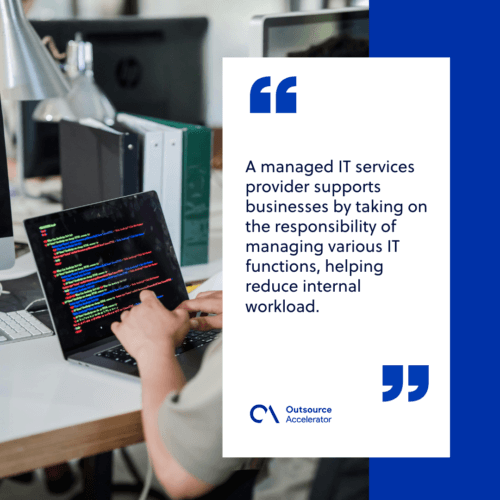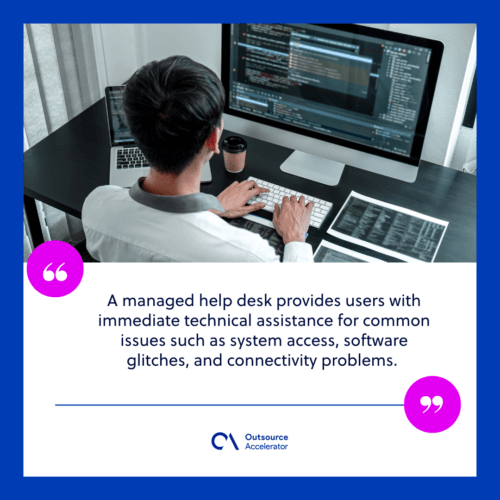Premier managed IT services in action

Setting up an IT team to handle a wide range of tasks can be a major challenge for growing businesses. As technology evolves, companies often face difficulties in hiring the right talent, maintaining consistent quality, and meeting tight project deadlines.
Balancing multiple IT demands, such as software development, cybersecurity, and infrastructure management, can stretch in-house teams thin. This can lead to dips in productivity and scalability.
To get around these challenges, many organizations turn to third-party providers for managed IT services. These partnerships allow businesses to streamline operations, reduce overhead, and gain access to specialized expertise.
This article explores how managed IT services can help growing companies effectively address their diverse technology needs.
How managed IT Services work
A managed IT services provider supports businesses by taking on the responsibility of managing various IT functions, helping reduce internal workload. It enables in-house teams to focus on core business goals.
External specialists often integrate with in-house teams, apply best practices, and bring valuable insights into process improvement and technology management.

Here’s how a typical managed IT service model works:
Evaluation
The process begins with a comprehensive review of the current software, systems, and infrastructure. This helps identify performance gaps, technical risks, and areas for improvement.
Scope definition
Leading third-party solutions providers collaborate with the client to define the scope, duration, and budget of the engagement. Alignment helps set clear goals and expectations.
Team selection
Based on the agreed scope, qualified IT professionals are selected and assigned to the project. These experts may work as a standalone team or as an extension of the client’s internal staff.
Service Level Agreement (SLA)
A formal agreement outlines the cooperation terms, including performance metrics, deliverables, and support levels. This document serves as the foundation for accountability.
Ongoing support
Services are delivered on-demand or continuously, based on the SLA. IT specialists provide proactive support and drive ongoing improvements to help businesses manage their technology more effectively.
5 Common managed IT services offered by leading BPOs
Reputable IT solutions companies usually have seasoned specialists, ready to take on managed IT services projects related to the following at any time:
1. Software management
Managed service providers help maintain optimal software performance and security while promoting user adoption.
By continuously monitoring system health and performance, they enhance both the functionality and user appeal of enterprise applications.
The result is a more productive, efficient, and engaging software experience.
Managed teams also assist with patch management, bug fixes, and compatibility updates to keep software running smoothly over time. Their proactive approach helps prevent issues before they affect users or disrupt business operations.
2. Application management
This service covers the full lifecycle of web and mobile applications, including maintenance, enhancements, and performance optimization. It’s tailored to meet the unique demands of each business.
Key components include:
- Continuous monitoring. Tools and custom solutions are used to monitor enterprise applications 24/7. This supports system availability across regions and devices, delivering a reliable user experience.
- Targeted troubleshooting. Any issues detected through monitoring are promptly analyzed and resolved. This includes addressing load imbalances, configuration errors, code issues, and performance bottlenecks.
- Ongoing enhancements. Beyond fixing problems, teams also suggest and implement updates or new features to keep applications modern, efficient, and easy to maintain.
3. IT help desk support
A managed help desk provides users with immediate technical assistance for common issues such as system access, software glitches, and connectivity problems.
Support can be delivered via multiple channels, including chat, phone, and email, offering quick resolutions and improving end-user satisfaction.
Help desk teams often operate around the clock to provide uninterrupted support, especially for global or remote workforces. They also track and analyze support requests to identify recurring issues and recommend long-term solutions.

4. Cloud infrastructure management
Managed service providers help businesses migrate to, maintain, and optimize cloud environments.
Cloud infrastructure management usually covers:
- Handling cloud configurations
- Monitoring usage and costs
- Securing cloud assets
- Scaling resources based on real-time needs
All these functions help reduce downtime and operational risk.
5. Cybersecurity services
Cybersecurity solutions providers often offer robust security services to protect IT systems from internal and external threats.
This type of managed IT services include:
- Vulnerability assessments
- Threat detection
- Firewall configuration
- Antivirus management
- Compliance monitoring
The goal is to help companies safeguard their digital assets and maintain regulatory standards.
Reliable IT solutions for evolving business needs
Managed IT service providers offer flexible, high-impact support that helps companies navigate complex tech challenges.
From software and application management to complete infrastructure oversight, these services empower businesses to reduce technical risks and increase operational efficiency.
For organizations looking to optimize their IT environments without the cost of building large in-house teams, managed IT services offer a smart, scalable solution.
Connect with a trusted IT solutions provider today to discover how expert support can help streamline your operations and fuel business growth.







 Independent
Independent




